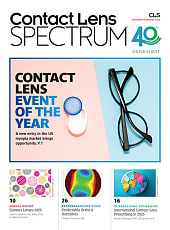Different Methods, Different Merits
In an era of staff retention woes and busy days that leave little time for training, managing contact lens replenishment for patients in-house is becoming less of a viable option for many practices. Enter systems like Abby, LensFerry, Marlo, and others that take care of not only shipping product but also reminding patients that it’s time to order.

EB connected with two eyecare professionals to reveal strategies for streamlining what can be a time-consuming process. Each optometrist utilizes a different method for replenishing the contact lens supply for patients.
→ Shelby Brogdon, O.D., Contact Lens Institute Visionary, of McFarland Eye Care in Little Rock, AR
→ Ashley McFerron, O.D., of Canby Eyecare in Canby, OR, a CooperVision Best Practice
▶ Maintaining a connection with patients.
Contact lens replenishment software removes the need to connect with patients throughout the ordering process to benefit practice operations. However, at McFarland Eye Care’s multiple locations, one staff member is the designated go-to in place of a replenishment system.
Dr. Brogdon: We have looked at some of these systems but haven’t found one that we feel would be beneficial to us yet. We utilize a specific contact lens technician at each office who is in charge of taking orders and communicating with patients. We find having a point person at each office is very helpful for patients to have a direct person handling their contacts [while taking] some burden off our doctors/tech.
At Canby Eyecare, the initial connection is established by providing basic information and incentives for patients before relinquishing the process to an automated system.
Dr. McFerron: We try to educate our patients that if there’s an issue, we’ll take care of you. We give patients a handout that describes the benefits of ordering your glasses in the office: If you run low, we’ll give you trial lenses. You get a discount on sunglasses if you order your supply.
The hope is that we don’t have to [maintain contact] because they love their contacts, everything’s great, and then they come back in the following year when they run out.
▶ Built-in recordkeeping for ultimate efficiency.
Beyond reminding patients and shipping product, a third-party contact lens replenishment system also includes features that improve operations within the practice.
Dr. McFerron: It used to be if people didn’t order your supply of contacts, you just go, “OK, let us know when you run out.” No one keeps tracking that.
To order the lenses, receive the lenses, open the box, put them in a tray for a patient, call or text the patient…it’s a lot of staff time. [The system] automatically does it all.
[Using CLX] keeps us from doing a lot of double entry. You enter the patient’s information in there one time, so in subsequent years, you can just search for the patient [without having to] add them in again. [Additionally, CLX has] an interface [that shows] where the lenses are in the queue—if they’re back-ordered, they just shipped, or have been delivered.
▶ Working alongside third-party systems for a hybrid approach.
It isn’t necessary to rely fully on a third-party system to handle contact lens replenishment. Instead, it can be utilized alongside in-house options, creating convenience for patients and the practice.
Dr. Brogdon: I can definitely see the advantages of using a direct-to-patient system, especially with a younger population of patients who are technology savvy and accustomed to using online ordering. I feel like it would not be as popular with some of our more mature patients [who] still prefer personal contact and ordering in person or over the phone.
Dr. McFerron: There’s one primary lens that we fit as many patients as possible. We keep that in stock and [prescribe] annual supplies. I believe that’s the easiest and the best for the patient and the practice.
For spherical patients who don’t need toric or multifocal lenses, we try to let them walk out with them that day. Goal No. 1 is to get patients to order a year’s supply in the office. [CLX provides] option No. 2—a backup to take some of the work off of us if they don’t walk out with that annual supply.



